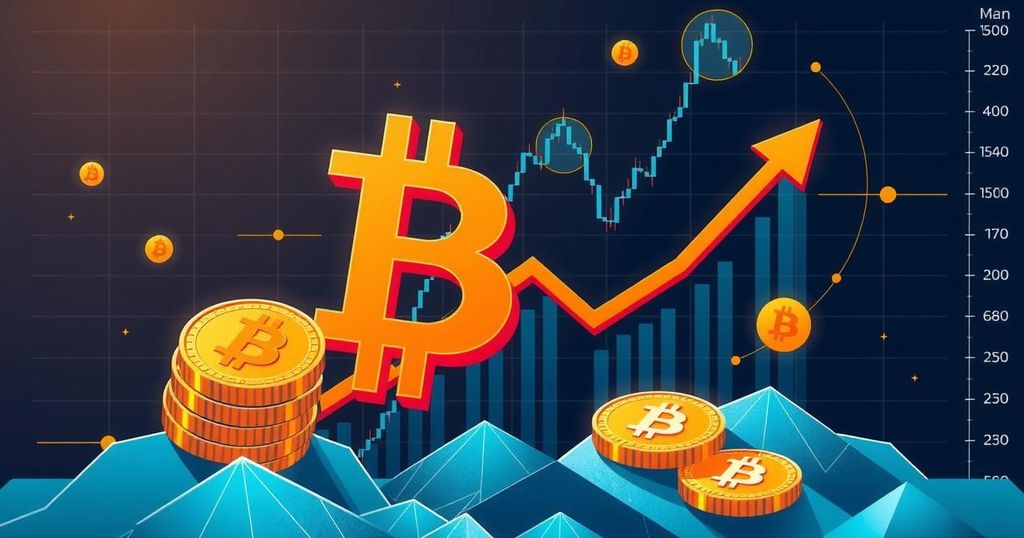Bitcoin Surges Above $66K Following Lighter US Inflation Data: Future Trends and Insights
Bitcoin (BTC) has exceeded $66,000 following a weaker US Core PCE inflation report, suggesting potential interest rate cuts by the Federal Reserve. This marks a bullish trend for Bitcoin, which has risen over 25% since early September. Upcoming political events and seasonal patterns point toward further possible gains in the final quarter of the year, with analysts speculating targets near $70,000 and even $100,000.
On Friday, Bitcoin (BTC) surpassed the $66,000 mark for the first time in nearly two months, driven by the release of a less-than-anticipated US Core Personal Consumption Expenditures (PCE) inflation report for August. This figure has raised optimism that the Federal Reserve may accelerate interest rate reductions, which could bolster the US economy and avert a recession projected for 2025. In the report, the headline PCE price index showed that US prices rose 2.2% year-on-year, down from 2.5% in July, and lower than the expected 2.3% rise. The month-over-month increase was in line with forecasts at 0.1%. Conversely, the Core PCE index rose by 2.7% annually, meeting expectations, but the monthly increase was slightly less than anticipated. This modest inflation underperformance prompted macroeconomic traders to increase their bets on a 50 basis point cut in interest rates at the Federal Reserve’s forthcoming November meeting. According to the CME Fed Watch Tool, market pricing shifted to indicate a 53.4% likelihood of this rate cut, up from 49.3%. Recent trends of potential monetary easing from the Federal Reserve and other significant central banks, along with reduced recession fears, have considerably influenced Bitcoin’s price trajectory over the last weeks. Currently, Bitcoin’s price has risen over 25% from its September lows of approximately $52,500, positioning it for a gain of about 12% by the end of the month, notable considering that September has historically been unfavorable for Bitcoin prices. Contrarily, October often establishes a base for bullish movements, with the fourth quarter typically experiencing positive momentum. Several indicators predict that Bitcoin may continue to rise in the upcoming quarter. Seasonal trends, coupled with expectations of a global easing cycle among central banks, could facilitate further gains. Additionally, the impending US Presidential election in November stands to significantly impact market sentiment; former President Donald Trump, a known advocate for cryptocurrencies, is slated to compete against Vice President Kamala Harris, who has recently exhibited a more favorable stance towards the crypto sector. A Trump victory could potentially catalyze a robust cryptocurrency rally, while a Harris win might still maintain a supportive environment for Bitcoin. Historically, Bitcoin rallies have been observed to accelerate approximately 170 days following a halving event, with peaks materializing about 480 days post-event. Although the current price surge, primarily driven by heightened Bitcoin ETF demand, might not replicate the vigorous intensity of past cycles, indicators suggest an optimistic outlook as we approach the close of 2024. Institutional interest in Bitcoin via ETFs has shown remarkable growth and is anticipated to persist in the coming weeks. Analysts forecast this trend will dominate market discussions and emphasize Bitcoin’s potential. Bitcoin advocates are now targeting key resistance levels, beginning at $70,000, with aspirations to challenge previous all-time highs near $74,000. Should the historical bullish trend for October carry through, a new record high may be on the horizon, with some analysts speculating that Bitcoin could target the $100,000 benchmark in the near future. In summary, a confluence of easing inflation, favorable actions from the Federal Reserve, significant political events, and established historical trends indicates a promising upward trajectory for Bitcoin as we advance into the last quarter of the year.
The subject of this article centers around the recent movements in Bitcoin’s price, particularly in light of US economic indicators such as inflation reports and Federal Reserve interest rate policy. The discussion spotlights the interplay between macroeconomic factors — including inflation rates, interest rates, and political conditions — and their impacts on cryptocurrency markets, particularly Bitcoin. Understanding the relationship between these variables provides important context for the price fluctuations observed within the Bitcoin market.
In conclusion, the recent surge in Bitcoin’s price above $66,000 is attributed to a combination of softer-than-expected inflation data and the likelihood of future interest rate cuts by the Federal Reserve. Given historical trends, upcoming political events, and the current interest in Bitcoin ETFs, there is significant potential for continued upward movement in Bitcoin’s price as we move into the final quarter of the year. Analysts are eyeing potential new highs, reflecting both bullish sentiment and underlying demand for the cryptocurrency.
Original Source: cryptonews.com




Post Comment